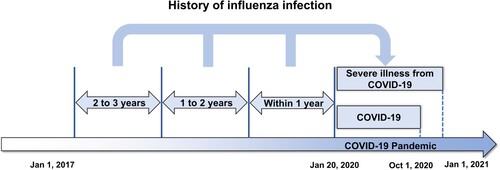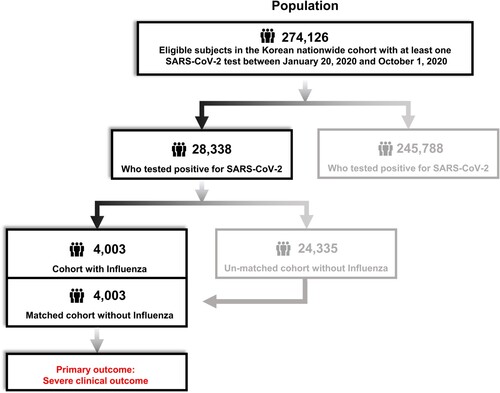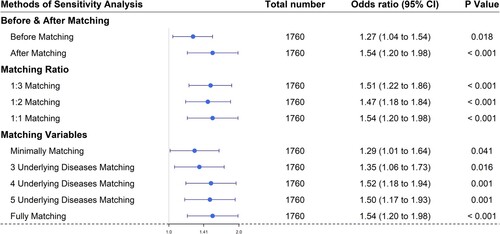Figures & data
Figure 1. The influenza-positive group was classified into five subgroups according to history of influenza infection within 1 year, 1–2 years, 2–3 years before the onset of the COVID-19 pandemic.

Figure 2. Distribution and flow chart of influenza and SARS-CoV-2 patients in a nationwide Korean cohort.

Table 1. Demographic characteristics of patients in the Korean nationwide cohort who underwent SARS-CoV-2 testing.
Table 2. Propensity score-matched baseline characteristics associated with severe illness from COVID-19 infection
Figure 3. Propensity score-matched association between influenza and severe clinical outcomes of COVID-19 in patients who tested positive for SARS-CoV-2. Sensitivity analysis was performed according to 1) matching ratio, 2) matching variables (minimally: age + sex + demography, 3 underlying diseases: minimally + HTN + DM + CKD matching, 4 underlying diseases: minimally + HTN + DM + CKD + lung diseases matching, 5 underlying diseases: minimally + HTN + DM + CKD + lung diseases + liver diseases matching, fully matching: minimally + HTN + DM + CKD + lung diseases + liver diseases + cardiac diseases (CHF + angina + MI) matching). (Abbreviations: HTN, hypertension; DM, diabetes mellitus; CKD, chronic kidney disease; CHF, congestive heart failure; MI, myocardial infarction).

Table 3. Propensity score-matched adjusted ORs for the risk of severe illness from COVID-19 in patients with previous influenza infection
Figure 4. Sensitivity analysis was performed according to 1) matching ratio, 2) matching variables (minimally: age + sex + demography, 3 underlying diseases: minimally + HTN + DM + CKD matching, 4 underlying diseases: minimally + HTN + DM + CKD + lung diseases matching, 5 underlying diseases: minimally + HTN + DM + CKD + lung diseases + liver diseases matching, fully matching: minimally + HTN + DM + CKD + lung diseases + liver diseases + cardiac diseases (CHF + angina + MI) matching). (Abbreviations: HTN, hypertension; DM, diabetes mellitus; CKD, chronic kidney disease; CHF, congestive heart failure; MI, myocardial infarction)

Data availability statement
The datasets analyzed in this study are stored in the Korean National Health Insurance claim-based database. The data will be made available for research on reasonable request and with permission from the National Health Insurance Service (NHIS) (NHIS-2022-1-382).
